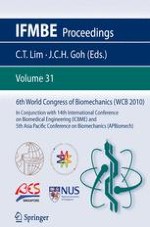2010 | OriginalPaper | Chapter
Comparison of the Effect of Different Mechanical Properties on the Stress Analysis of Tibia under Transversal Impact Loading Using Finite Element Method
Authors : B. Sepehri, A. Ashofte Yazdi, G. Rouhi
Published in: 6th World Congress of Biomechanics (WCB 2010). August 1-6, 2010 Singapore
Publisher: Springer Berlin Heidelberg
Activate our intelligent search to find suitable subject content or patents.
Select sections of text to find matching patents with Artificial Intelligence. powered by
Select sections of text to find additional relevant content using AI-assisted search. powered by
In the recent years many models have been proposed to analyze the injury mechanisms of the human lower extremities such as simulation of vehicle-pedestrian collisions. Also, many dynamic load tests have been performed to obtain fundamental information on the fracture behavior and morphology of the human bones, e.g. for tibia. On the other hand, numerical methods, for instance finite element method, are being widely employed to estimate mechanical stimuli in bones in order to get useful information on the mechanical properties and behavior of the bone tissue.
In this research, a 3D model of tibia was created with the exact geometry of the real bone by using spiral scan images of the human left leg. It was materialized by MIMIX and developed in ABAQUS software by considering other in-vivo conditions, and also by loading a transversal impact which represents the collision of a vehicle and pedestrian. Three different mechanical properties, i.e. elastic isotropic; elastic but transversely isotropic; and finally viscoelastic were considered for the bone tissue to see and compare its behavior under the impact. Tibia was assumed to act as a cortical shell and so the spongy bone was ignored because of its much lower stiffness than the cortical shell [1].
Our results showed that the stresses in tibia, after the impact are at the same level as the ultimate stress of long bones. Interestingly, the maximum stress resulted from the impact loading, was seen in the viscoelastic model of tibia and the minimum was found to be when an elastic and transversely isotropic material property was considered for the tibia. Moreover, because of the viscoelastic property of tibia, it was seen that it has the capability to differ the rate of fracture propagation and also there will be an increase in the amount of stress as time goes on during the impact cycle but once loading period is over, stress relaxation was observed in which stress decreased. This was verified by checking the amounts of stress for each increment of the impact cycle. The maximum stress was seen in the last increment of the impact cycle when tibia’s viscoelasticity was taken into account, while for the purely elastic, it’s happened when the maximum load was applied.
